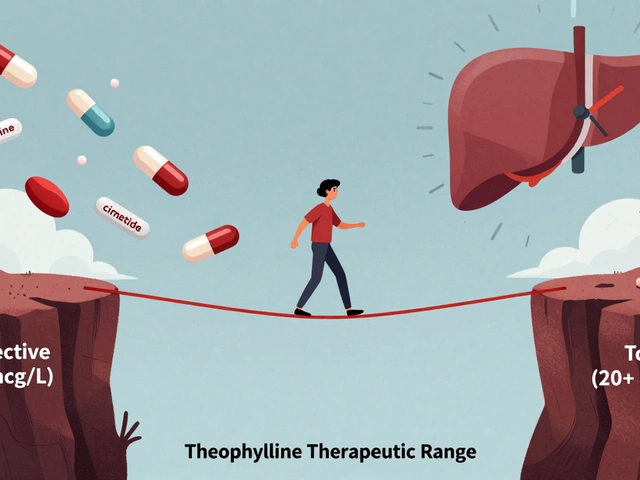
Dandruff Severity Calculator
Dandruff Severity Calculator
Get personalized recommendations for your treatment plan
Your Treatment Plan
Based on your responses, here's your personalized recommendation:
Recommended shampoo concentration:
Usage frequency:
Expected improvement timeline:
Quick Takeaways
- Ketoconazole shampoo targets the fungus Malassezia, a key trigger of dandruff and seborrheic dermatitis.
- Use 2% concentration for most cases; 1% works for maintenance.
- Apply, lather, leave for 3‑5 minutes, then rinse; repeat 2‑3 times a week initially.
- Combine with gentle scalp hygiene and avoid heavy styling products for best results.
- Seek a dermatologist if symptoms persist after 4‑6 weeks.
What Are Dandruff and Seborrheic Dermatitis?
When it comes to treating dandruff, ketoconazole shampoo is a go‑to option. But before you grab the bottle, it helps to know what you’re actually fighting.
Dandruff is a common scalp condition marked by flaky, white or yellowish skin that sheds in clumps. Most people blame dry skin, but research shows a fungus called Malassezia often drives the inflammation.
Seborrheic Dermatitis is a more severe, oily form of dandruff that can affect the eyebrows, ears, and even the chest. It’s not just a cosmetic issue; the itching can be intense, and lesions may become red and greasy.
Both conditions share the same culprit fungus, which is why an antifungal approach works for both.
How Ketoconazole Shampoo Works
Ketoconazole Shampoo is a medicated shampoo that contains the antifungal agent ketoconazole, usually at 1% or 2% concentrations. The drug interferes with the fungus’s cell membrane, halting its growth and reducing scalp inflammation.
A 2023 clinical trial published in the *Journal of Dermatological Treatment* found a 73% reduction in flake count after four weeks of twice‑weekly use of 2% ketoconazole shampoo, compared with a 42% drop using zinc pyrithione.
Because ketoconazole also has mild anti‑inflammatory properties, it tackles both the cause (fungus) and the symptom (redness).
Choosing the Right Product
Not all ketoconazole shampoos are created equal. Here’s what to look for on the label:
- Active concentration: 2% for moderate‑to‑severe cases; 1% for maintenance or mild symptoms.
- Formulation: Look for a pH‑balanced base (around 5.5) to keep the scalp barrier intact.
- Additional ingredients: Aloe, tea tree oil, or glycerin can soothe irritation, but avoid heavy silicones if you tend to get oily buildup.
Brands like Nizoral, Extina, and generic store‑brand options meet these criteria, but always check the expiry date - ketoconazole degrades over time.

Step‑by‑Step: How to Use Ketoconazole Shampoo Effectively
- Wet your hair thoroughly. Water temperature should be lukewarm; hot water can strip natural oils and worsen irritation.
- Apply a generous amount. About the size of a quarter for short hair, a golf‑ball for longer hair.
- Massage into the scalp. Use fingertip pressure, not nails, to avoid micro‑abrasions.
- Let it sit. Keep the lather on your scalp for 3-5 minutes. This is the critical contact time for ketoconazole to act on the fungus.
- Rinse completely. No residue should remain; lingering shampoo can cause buildup.
- Frequency. Start with two applications per week (e.g., Monday and Thursday) for the first four weeks. If your scalp improves, drop to once a week for maintenance.
After the initial treatment phase, you can switch to a gentle, sulfate‑free daily shampoo to keep the scalp clean without over‑drying.
Tips for Maximising Results
- Don’t over‑wash. Stripping natural oils can create a favorable environment for Malassezia.
- Avoid heavy styling products. Gels, waxes, and sprays can trap moisture and feed the fungus.
- Use a soft‑bristle brush. It helps distribute the shampoo evenly and removes loose scales.
- Watch your diet. High‑sugar, high‑fat diets may exacerbate inflammation; consider adding omega‑3 rich foods.
- Stay consistent. Skipping weeks often leads to flare‑ups within 2-3 days.
When to See a Dermatologist
If you notice any of the following, schedule an appointment:
- Persistent redness, swelling, or crusted plaques after 4-6 weeks of consistent use.
- Hair loss in patches - could signal secondary infection.
- Severe itching that disrupts sleep or daily activities.
A dermatologist may prescribe a higher‑strength (e.g., 2% ketoconazole combined with a short course of a topical corticosteroid) or suggest oral antifungal therapy for refractory cases.

Comparison of Common Scalp Treatments
| Treatment | Active Ingredient | Typical Concentration | Use Frequency | Pros | Cons |
|---|---|---|---|---|---|
| Ketoconazole Shampoo | Ketoconazole | 1% - 2% | 2×/week (initial) → 1×/week (maintenance) | Targets fungus & inflammation; strong clinical evidence | Can cause mild irritation; prescription needed in some regions |
| Coal Tar Shampoo | Coal Tar | 0.5% - 5% | 2-3×/week | Effective for psoriasis‑like scaling | Strong odor; may stain light hair; potential carcinogen concerns |
| Selenium Sulfide Shampoo | Selenium Sulfide | 1% - 2.5% | 2×/week | Reduces Malassezia; inexpensive | Can discolor light hair; occasional scalp irritation |
| Zinc Pyrithione Shampoo | Zinc Pyrithione | 1% - 2% | Daily or alternate days | Gentle; good for mild dandruff | Less effective for severe seborrheic dermatitis |
For most adults battling both flaking and redness, ketoconazole tops the list because it hits the root cause. Choose a different option only if you have a specific intolerance or need a milder daily regimen.
Mini‑FAQ
Can I use ketoconazole shampoo on color‑treated hair?
Yes, but choose a formula labeled safe for color. Avoid leaving the shampoo on for longer than 5 minutes, as prolonged exposure can fade dye.
Is a prescription required for 2% ketoconazole shampoo?
In Australia, 2% ketoconazole shampoo is prescription‑only, while 1% is available over the counter. Talk to your pharmacist or doctor for the right strength.
How long does it take to see results?
Most users notice reduced flaking within 7‑10 days. Full improvement of redness and oiliness may take 3‑4 weeks.
Can I combine ketoconazole shampoo with other treatments?
Yes. Using a gentle daily shampoo on non‑treatment days is fine. Avoid stacking two antifungal shampoos on the same day to prevent irritation.
What side effects should I watch for?
Mild itching, tingling, or temporary dryness are common. Stop use and see a doctor if you develop severe burning, swelling, or rash.
Next Steps
Grab a 2% ketoconazole shampoo, follow the routine above, and keep a simple log of flake count and itching level. After four weeks, reassess - you’ll likely see a dramatic drop in both. If not, a dermatologist can prescribe a short corticosteroid boost or explore oral options.






6 Comments
It is incumbent upon the discerning reader to acknowledge that ketoconazole's antifungal efficacy is not merely a marketing ploy but a consequence of its interference with ergosterol synthesis in Malassezia species. Moreover, the seemingly innocuous over‑the‑counter availability of 1 % formulations masks a broader agenda of pharmaceutical complacency, wherein regulatory bodies tacitly endorse sub‑optimal concentrations to sustain perpetual consumer dependence. One must also consider the geopolitical ramifications of sourcing ketoconazole precursors, which are often extracted in regions with lax environmental oversight, thereby contributing to undisclosed ecological externalities. Consequently, reliance on a single active agent without addressing ancillary factors-such as scalp pH imbalance, diet, and comorbid dermatological conditions-constitutes a myopic approach. In sum, a comprehensive therapeutic protocol should integrate antifungal action with systemic considerations to thwart the insidious proliferation of resistance.
/p>It is both a privilege and a responsibility to disseminate evidence‑based guidance on scalp health, particularly when the subject matter intertwines microbiology, dermatology, and patient adherence.
/p>First, one must recognize that the fungal genus Malassezia thrives in lipid‑rich environments, which explains its predilection for sebaceous‑rich regions such as the scalp, eyebrows, and nasolabial folds.
Second, the pharmacodynamics of ketoconazole involve the inhibition of lanosterol 14α‑demethylase, an enzyme essential for ergosterol synthesis, thereby destabilizing the fungal cell membrane and curbing proliferation.
Third, clinical data from randomized controlled trials consistently demonstrate a reduction in flake count ranging from 60 % to 75 % after a four‑week regimen of twice‑weekly application of a 2 % preparation.
Fourth, the anti‑inflammatory properties of ketoconazole, though modest, contribute to the amelioration of erythema and pruritus, which are often the most distressing symptoms for patients.
Fifth, patient education regarding proper application-wetting the hair with lukewarm water, using an appropriate volume of shampoo, massaging gently, allowing a contact time of three to five minutes, and rinsing thoroughly-cannot be overstated, as suboptimal technique diminishes drug exposure.
Sixth, the incorporation of a pH‑balanced base, ideally around 5.5, safeguards the integrity of the scalp barrier while facilitating optimal drug absorption.
Seventh, adjunctive agents such as aloe vera, tea tree oil, or glycerin may provide soothing effects, yet one must vigilantly avoid heavy silicones that could entrap moisture and foster fungal resurgence.
Eighth, lifestyle modifications, including reduction of refined sugars and incorporation of omega‑3 fatty acids, have been correlated with decreased inflammatory markers and may synergize with pharmacotherapy.
Ninth, the frequency schedule-commencing with two applications per week for the initial month, followed by a maintenance dose of once weekly-balances efficacy with the risk of irritation.
Tenth, in cases where the scalp exhibits persistent redness, scaling, or secondary bacterial infection despite adherence to the regimen, escalation to a combined therapy featuring a short course of topical corticosteroids or oral antifungal agents should be contemplated.
Eleventh, it is prudent to counsel patients on the potential for mild adverse effects such as transient itching, dryness, or a brief tingling sensation, emphasizing that these symptoms typically resolve with continued use or adjunctive moisturization.
Twelfth, monitoring progress through a simple log of flake count and itch intensity empowers patients to visualize improvement and reinforces compliance.
Thirteenth, it is essential to advise individuals with color‑treated hair to select formulations explicitly labeled as safe for dyed locks to prevent premature fading.
Fourteenth, the regulatory landscape varies globally; for instance, in certain jurisdictions a 2 % concentration may necessitate a prescription, whereas 1 % is readily obtainable over the counter.
Fifteenth, awareness of product expiration dates is critical, as ketoconazole degrades over time, diminishing its antifungal potency.
Finally, a holistic approach that melds pharmacological intervention with mindful scalp hygiene, judicious product selection, and supportive lifestyle choices offers the greatest probability of sustained remission and patient satisfaction.
Honestly, if you’re still slapping shampoo on your head without a plan, you’re just spinning your wheels. Two washes a week is fine, but most people forget the three‑to‑five minute sit‑time, so they never get the full effect. Also, ditch the heavy gels unless you want a fungus fiesta on your scalp. Bottom line: stick to the schedule or you’ll be back where you started.
/p>Listen, the half‑hearted effort you described is exactly why many give up early; you need to commit to the full protocol or accept failure. Grab the bottle, apply the recommended amount, massage it in, and set a timer for at least four minutes-no excuses. Pair it with a gentle sulfate‑free shampoo on off‑days to keep the scalp clear without over‑stripping. If you stay disciplined, the results will speak for themselves, and you’ll finally shut down that flaky mess.
/p>Stop using cheap silica gels; they feed the fungus.
/p>Exactly, heavy silicones create a perfect breeding ground for Malassezza, so swapping to lightweight, silicone‑free conditioners can drastically reduce re‑colonization. A simple rinse‑off after the ketoconazole treatment keeps the scalp breathable and the fungus at bay :)
/p>